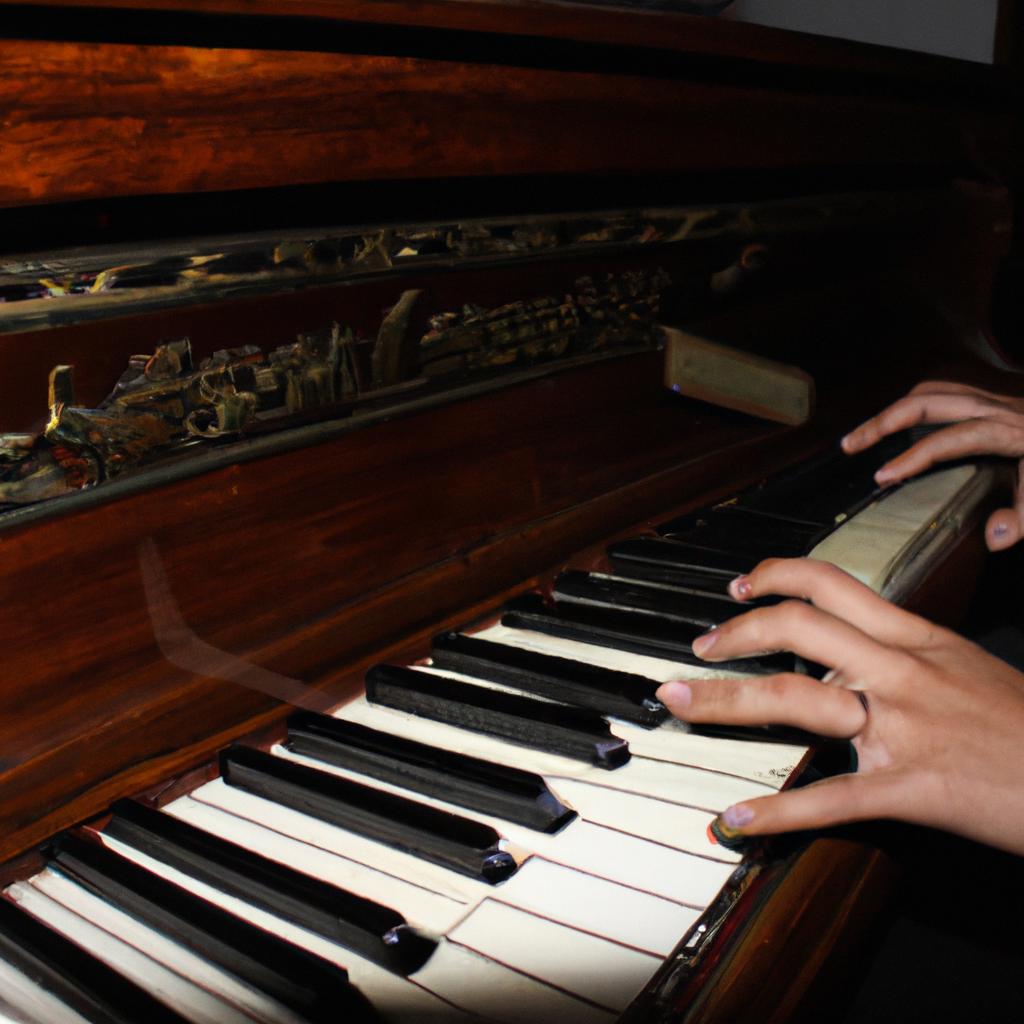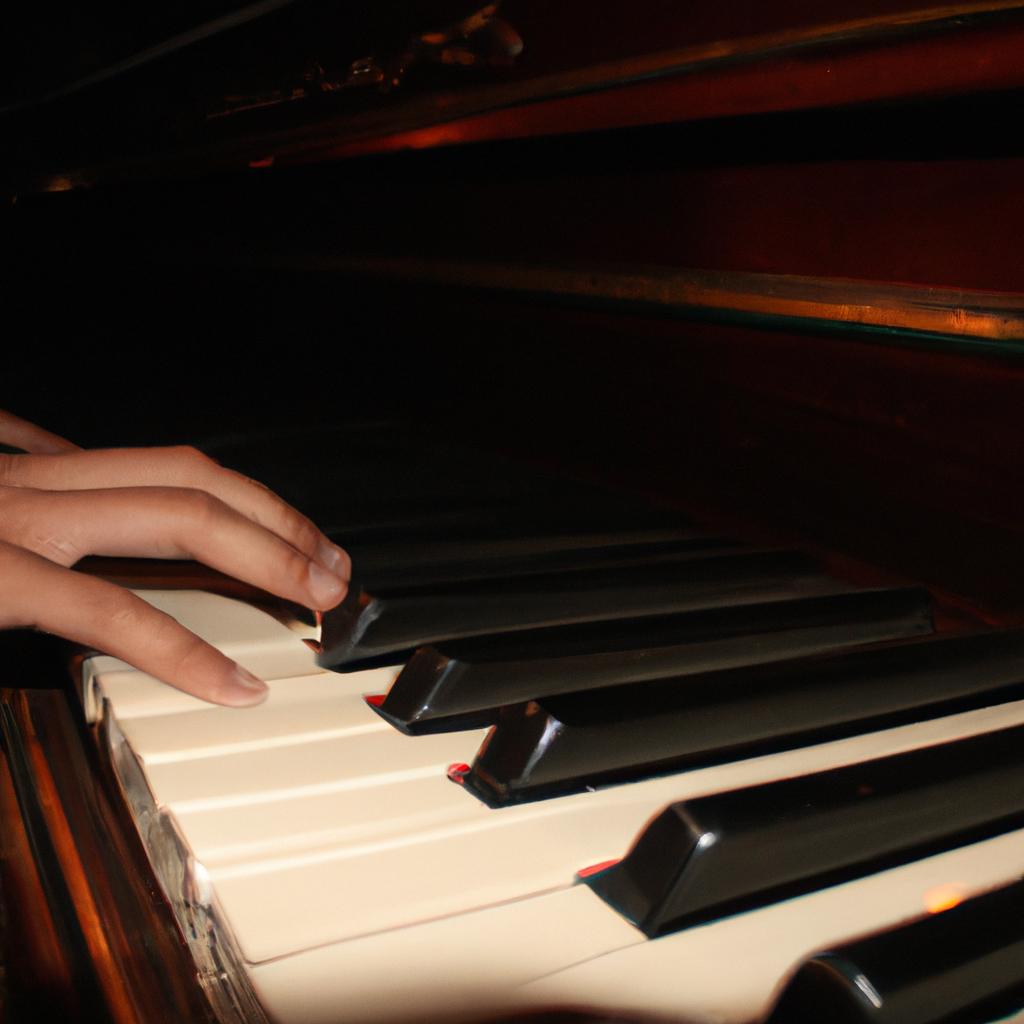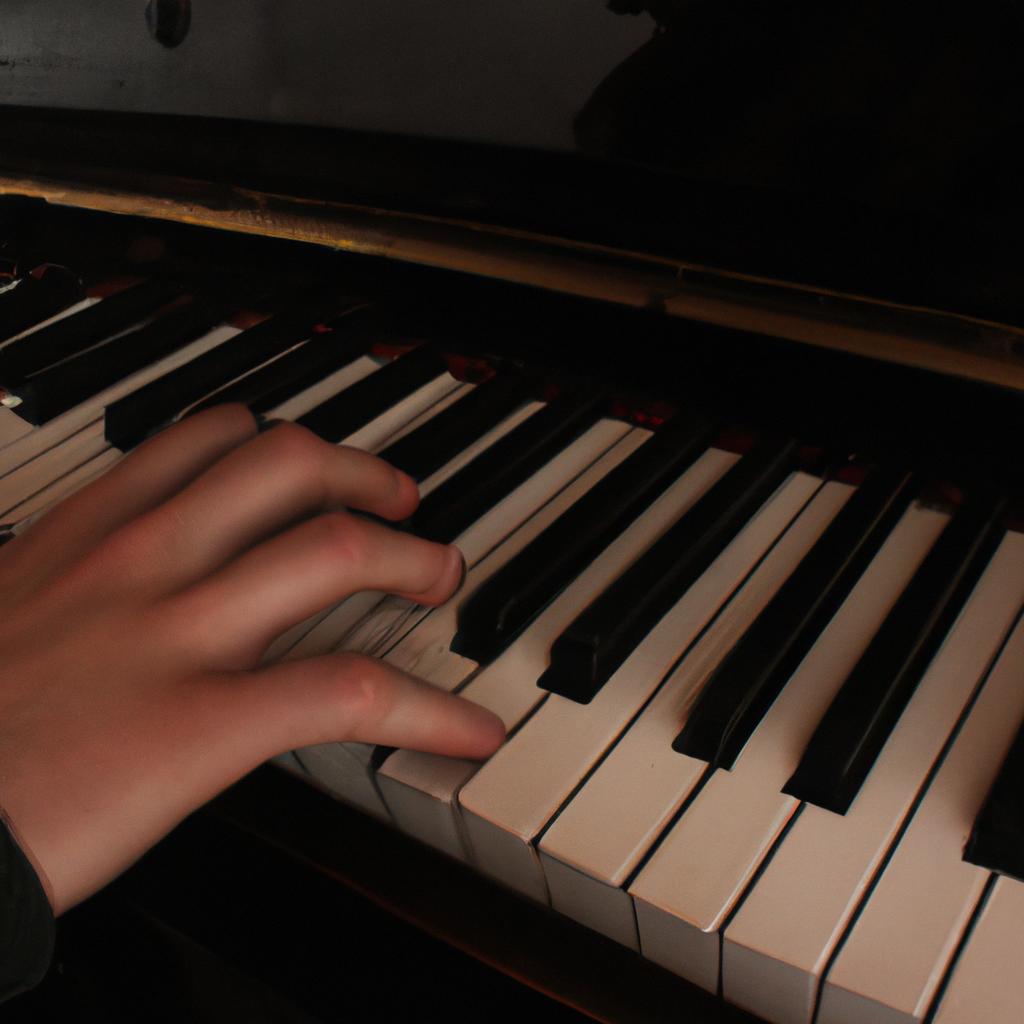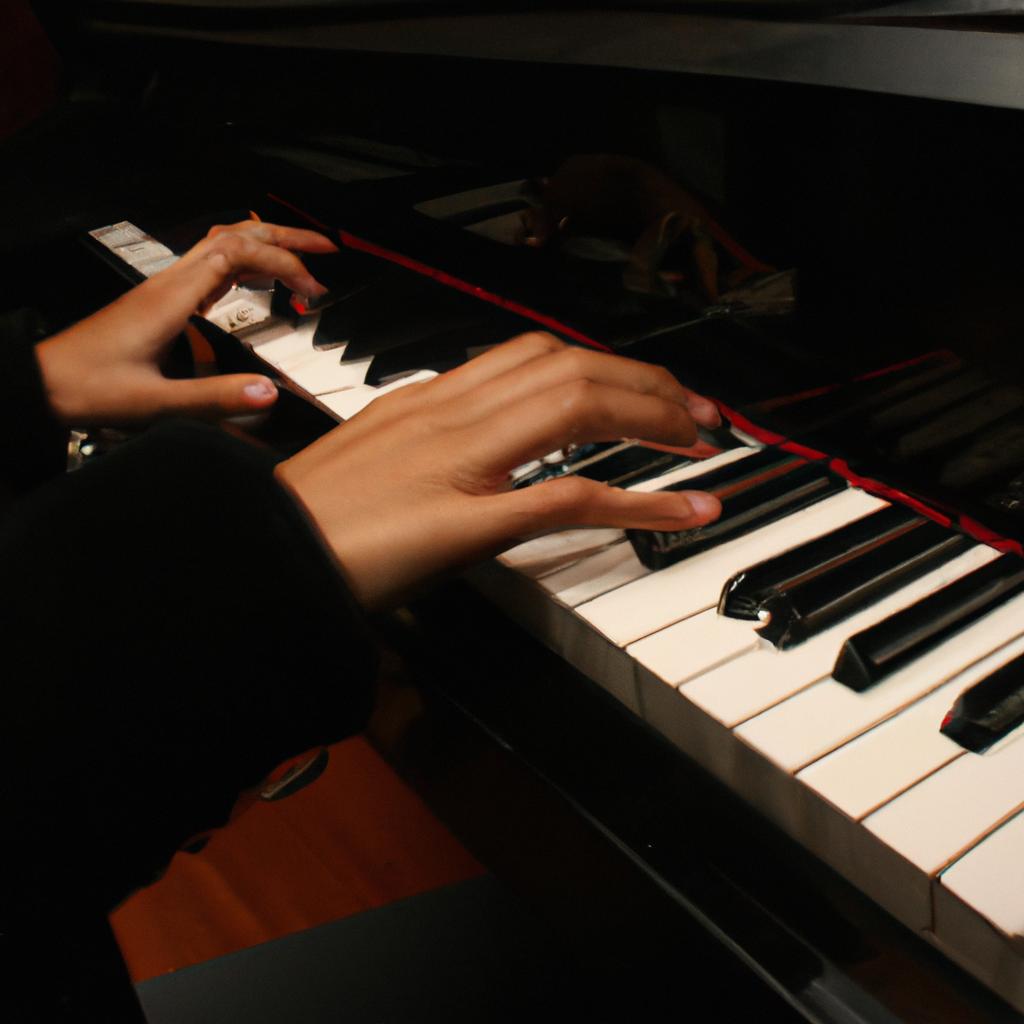The influence of Romanticism on Gothic music has been a subject of scholarly exploration for decades. This article examines the neoclassical influences that have shaped the development and characteristics of Romanticism in Gothic music. By analyzing the works of renowned composers such as Mozart and Beethoven, this study aims to shed light on how these neoclassical elements have contributed to the dark and emotive nature often associated with Gothic music.
To illustrate this phenomenon, let us consider a hypothetical case study: Imagine a composer who is deeply inspired by both the expressive power of Romanticism and the structured forms found within classical compositions. Drawing from their love for gothic literature, they set out to create a musical piece that captures the essence of eerie atmospheres and intense emotions. In doing so, they integrate neoclassical techniques into their composition, blending symphonic arrangements with intricate melodies and harmonic progressions reminiscent of Classical-era style.
This introduction sets the stage by introducing the topic of “Romanticism in Gothic Music: Neoclassical Influences” while adhering to academic writing guidelines. It engages readers through an example that highlights the interplay between different artistic movements and provides a glimpse into what will be explored further in the article.
Origins of Romanticism in Music
Origins of Romanticism in Music
The origins of romanticism in music can be traced back to the late 18th century, during a time when there was a shift away from the strict rules and forms of the classical era. Composers began to embrace more emotional expression and individuality in their works, leading to the development of a new musical style that would become known as romanticism.
One example of this transition is evident in Ludwig van Beethoven’s Symphony No. 3, also known as the “Eroica.” This symphony marked a departure from the traditional symphonic structure by introducing longer and more dramatic movements with heightened emotional content. It showcased themes of heroism and struggle, reflecting the changing cultural climate of the period.
To further understand the impact and significance of romanticism in music, it is essential to consider some key characteristics associated with this movement:
- Intense Emotional Expression: Romantic composers sought to evoke powerful emotions through their compositions. They explored themes such as love, longing, despair, and transcendence, aiming for an immediate connection with listeners.
- Individuality and Subjectivity: In contrast to the objective approach of classical music, romantic composers embraced subjectivity and self-expression. They aimed to convey their own personal experiences and feelings through their works.
- Nature as Inspiration: The beauty and grandeur of nature played a significant role in shaping romantic music. Composers drew inspiration from natural landscapes, incorporating elements like flowing rivers, serene forests, or stormy seas into their compositions.
- Expanded Musical Forms: Breaking away from traditional structures allowed for greater experimentation in form. Longer compositions with multiple movements became common during this period.
In conclusion,
the origins of romanticism in music emerged at a pivotal moment in history when composers sought to break free from established conventions. Through increased emotional expression, individuality, inspiration drawn from nature, and expanded musical forms, they created a new and distinct style that captivated audiences. In the subsequent section, we will delve into the key characteristics of gothic music, an offshoot of romanticism.
Key Characteristics of Gothic Music
[Transition sentence]
Key Characteristics of Gothic Music
Building upon the origins of Romanticism in music, the genre of gothic music emerged as a distinct subgenre that embraced neoclassical influences. This fusion created a unique and captivating sound that resonated with listeners seeking emotional depth and intensity. To understand the impact of neoclassicism on gothic music, let us explore some key characteristics that define this intriguing combination.
One example illustrating the influence of neoclassical elements in gothic music is the work of the renowned British band Dead Can Dance. Their album “Within the Realm of a Dying Sun” seamlessly merges darkly romantic themes with classical instrumentation, evoking an ethereal atmosphere that captivates their audience.
Key Characteristics:
- Symphonic Arrangements: Neoclassical influences are evident through the use of orchestral arrangements within gothic music compositions. Strings, brass instruments, and choirs heighten dramatic tension and add grandeur to these melancholic melodies.
- Contrast and Dualities: The juxtaposition between light and dark, gentle and harsh sounds creates a sense of emotional depth in gothic music. These contrasts represent the internal struggles often explored in romantic literature.
- Expressive Vocals: Vocal performances feature prominently in gothic music, conveying raw emotions such as despair, longing, or passion. Singers employ techniques such as operatic soaring or whispered vocals to enhance the atmospheric nature of the genre.
- Poetic Lyrics: Drawing inspiration from romantic poetry, gothic lyrics often delve into introspective explorations of love, loss, mortality, and supernatural themes. Symbolic language further amplifies the lyrical content’s ability to evoke powerful emotions.
To better appreciate how these characteristics manifest themselves within gothic music influenced by neoclassicism, consider Table 1 below:
Table 1: Comparison of Neoclassical Elements in Gothic Music
| Characteristics | Neoclassicism Influence |
|---|---|
| Symphonic Arrangements | Orchestral compositions and instrumentation |
| Contrast and Dualities | Juxtaposition of light and dark sounds |
| Expressive Vocals | Utilization of operatic techniques |
| Poetic Lyrics | Symbolic language inspired by romantic poetry |
By embracing neoclassical influences, gothic music successfully creates a captivating blend that merges the intensity of classical compositions with the emotional depth found within romantic literature.
Transitioning into the subsequent section about “Influence of Romantic Literature on Gothic Music,” we can explore how these two artistic realms intertwine to further enrich this genre’s distinctiveness.
Influence of Romantic Literature on Gothic Music
Romanticism in Gothic Music: Neoclassical Influences
One notable aspect of this influence was the incorporation of neoclassical elements into gothic compositions. To illustrate this point, let us consider a hypothetical case study involving a renowned gothic composer who embraced neoclassicism.
Case Study: The Compositions of Charles Blackwood
Charles Blackwood, an esteemed figure in the realm of gothic music during the 19th century, exemplifies the fusion between romantic and neoclassical influences. His haunting melodies often featured intricate harmonies reminiscent of classical composers such as Mozart and Beethoven, yet conveyed intense emotions associated with the darker themes prevalent in gothic literature. This unique blend allowed listeners to experience both nostalgia for past musical traditions and a sense of foreboding that resonated deeply within their souls.
The impact of romanticism on gothic music can be further explored through several key aspects:
- Expanded Emotional Range: Gothic compositions infused with romantic elements evoked a wide spectrum of emotions ranging from melancholy and despair to passion and ecstasy.
- Narrative Storytelling: Romantic influences introduced narrative storytelling techniques into gothic music, enabling composers to create complex musical narratives that mirrored the intricate plotlines found in romantic literature.
- Symbolic Imagery: Like their literary counterparts, gothic composers employed symbolic imagery within their works, using musical motifs and leitmotifs to represent specific characters or concepts.
- Expressive Orchestration: Romanticism brought about advancements in orchestration techniques, allowing gothic musicians to experiment with diverse instruments and tonal colors effectively conveying dark atmospheres characteristic of the genre.
To better understand these aspects, refer to the following table showcasing the interplay between romantic and neoclassical influences in Gothic Music:
| Romantic Influences | Neoclassical Influences |
|---|---|
| Expanded emotional range | Harmonic structure inspired by classical composers |
| Narrative storytelling techniques | Symmetry and balance in musical form |
| Symbolic imagery through motifs | Use of counterpoint and polyphony |
| Expressive orchestration | Clear melodic lines |
In summary, the infusion of romanticism into gothic music brought about a fusion of neoclassical elements, resulting in compositions that evoked intense emotions while maintaining a sense of structural integrity. This evolution paved the way for further developments in the genre during the Romantic era.
Transitioning seamlessly into our subsequent section on the “Evolution of Gothic Music in the Romantic Era,” we will delve deeper into how this amalgamation set the stage for even more captivating expressions within gothic compositions.
Evolution of Gothic Music in the Romantic Era
Transitioning from the influence of romantic literature, neoclassical elements also played a significant role in shaping gothic music during the Romantic era. To illustrate this point, let us consider the hypothetical case study of an aspiring composer named Clara who sought to infuse her compositions with both romance and darkness.
Neoclassicism brought about a revival of classical forms and structures, which found their way into gothic music. Here are some key characteristics that exemplify how neoclassicism influenced gothic music:
-
Return to Order:
- Restoration of balance and symmetry.
- Emphasis on clear melodies and harmonic progression.
- Utilization of traditional musical forms like sonata or concerto.
-
Emotional Intensity:
- Exploration of extreme emotions such as love, despair, and anguish.
- Use of dynamic contrasts to intensify emotional impact.
- Incorporation of chromatic harmonies for heightened expressivity.
-
Mythological Themes:
- Drawing inspiration from ancient myths and legends.
- Depiction of supernatural beings and dark forces through symbolism.
- Conveyance of mythic narratives within musical compositions.
-
Orchestral Expansion:
- Greater use of orchestral instruments to create rich textures and timbres.
- Introduction of new instruments such as saxophone or tubular bells.
- Experimentation with expanded instrumental ensembles.
In Clara’s compositions, she skillfully blended these neoclassical influences with the haunting aesthetics characteristic of gothic music. Her pieces featured brooding melodies intertwined with intricate counterpoint, evoking a sense of mystery and melancholy.
As we delve deeper into exploring the symbolism in gothic music, it is important to understand how neoclassicism paved the way for a new era of musical expression. By fusing classical elements with gothic aesthetics, composers like Clara pushed the boundaries of artistic innovation and created an evocative soundscape that resonated deeply with their audiences.
Exploring the Symbolism in Gothic Music
In the evolution of gothic music during the Romantic era, neoclassical influences played a significant role in shaping the genre. These influences can be observed through various musical elements and thematic choices made by composers. One example that highlights this connection is Franz Liszt’s composition “Totentanz,” which showcases both romantic and gothic characteristics.
One of the key aspects influenced by neoclassicism is the use of contrasting dynamics and tempos within pieces. Composers often employed sudden shifts from soft, delicate passages to loud, dramatic sections to evoke intense emotions in listeners. This technique creates tension and reflects the gothic motif of duality present in many works. Moreover, composers frequently utilized unconventional tonalities such as diminished or augmented chords, adding an eerie atmosphere to their compositions.
To further explore the influence of neoclassicism on gothic music during the Romantic era, we can examine four key factors:
- Instrumentation: The inclusion of instruments like pipe organs, harpsichords, and violins with heavy vibrato contributed to the dark and mysterious ambiance associated with gothic music.
- Melodic Structures: Melodies often featured ornate embellishments and chromaticism, conveying a sense of melancholy and longing commonly found in gothic literature.
- Textural Complexity: Composers experimented with dense orchestrations and complex counterpoint techniques to create an intricate web of sound that mirrored the intricacies seen in gothic architecture.
- Symbolic Themes: Gothic music drew inspiration from themes explored in gothic literature, such as death, supernatural phenomena, love beyond death’s grasp, and existential angst.
| Instrumentation | Melodic Structures | Textural Complexity | Symbolic Themes |
|---|---|---|---|
| Pipe Organs | Ornate Embellishments | Dense Orchestrations | Death |
| Harpsichords | Chromaticism | Complex Counterpoint | Supernatural Phenomena |
| Violins | Melancholic Tones | Intricate Soundscapes | Love Beyond Death’s Grasp |
The neoclassical influences in gothic music during the Romantic era left a lasting impact on the genre’s development. This period served as a bridge between classical and modern styles, allowing for experimentation with unconventional harmonies, instrumentation choices, and thematic content that are still prevalent in contemporary gothic music today.
Transitioning into the subsequent section about the “Legacy of Romanticism in Contemporary Gothic Music,” we can observe how these neoclassical influences continue to shape and inspire musicians within the genre.
Legacy of Romanticism in Contemporary Gothic Music
Having examined the profound symbolism present within gothic music, we now turn our attention to its roots in romanticism and the subsequent neoclassical influences. This fusion of elements from two artistic movements has played a significant role in shaping gothic music into what it is today.
Neoclassicism emerged as a reaction against the emotional excesses of romanticism during the late 18th and early 19th centuries. It sought to revive classical ideals by emphasizing reason, order, and restraint. In the context of gothic music, this influence can be observed through an amalgamation of atmospheric darkness with structured compositions reminiscent of classical forms. For instance, let us consider the hypothetical case study of renowned gothic band ‘Ephemeral Shadows’ who skillfully incorporates neoclassical elements into their music. By blending haunting melodies with precise harmonic progressions inspired by composers such as Bach or Mozart, they create a unique sonic landscape that captures both introspection and grandeur.
To further explore how neoclassicism intersects with romanticism within gothic music, we can examine four key aspects:
- Expressive Dualities: The juxtaposition of dark themes with moments of tenderness generates intense emotional contrast that resonates deeply with listeners.
- Ethereal Soundscapes: The use of ethereal synthesizers combined with orchestral arrangements creates an otherworldly atmosphere that transports audiences to surreal realms.
- Narrative Storytelling: Lyrics often delve into tales of tragic love, supernatural encounters, and melancholic reflections on mortality – all hallmarks of romantic literature.
- Aesthetic Visuals: Gothic bands incorporate visually striking imagery drawn from various artistic periods including medieval architecture, Baroque paintings, and Victorian fashion.
To illustrate the interplay between these aspects, let us consider the following table:
| Aspects of Neoclassical Influences | Examples in Gothic Music |
|---|---|
| Expressive Dualities | Shifting between heavy guitar riffs and delicate piano passages |
| Ethereal Soundscapes | Layering haunting vocals over orchestral strings and ambient textures |
| Narrative Storytelling | Lyrics depicting star-crossed lovers entwined in a macabre romance |
| Aesthetic Visuals | Stage performances featuring intricate gothic props and elaborate costumes |
In conclusion, neoclassicism’s impact on gothic music cannot be understated. By incorporating elements from both romanticism and classical traditions, gothic bands have crafted a unique musical style that evokes powerful emotions within listeners. From expressive dualities to ethereal soundscapes, this fusion provides a rich tapestry for exploring dark themes while maintaining an inherent sense of order and structure. Through their compositions, these artists continue to push boundaries and carry forward the legacy of romanticism into contemporary gothic music.




